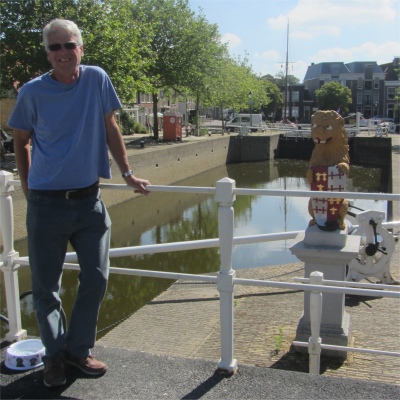 Lion in Rommelhaven Mocking Rex's Back |
The little bridge a few metres from us soon became a major thoroughfare for all the parents taking their offspring to school. Older children were flying across the bridge on their bikes. After the school run the bridge became a major route for battalions of mobility scooters.
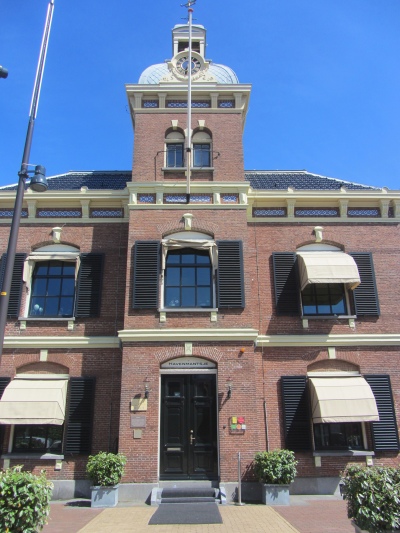 't Havenmantsje |
"Brum Alkmaar, short for Abraham," the old chap said as he introduced himself. Yes, he was open, so I signalled Rex to come on down. The chap spoke good English, and was enthusiastic and keen; we were his only customers. A small hut, the visitor centre, contained a wealth of old paintings, woodcuts, prints, and ancient and modern maps linked to the story of a trip by Willem Barentsz and his men. The story is one of the most heroic in Dutch maritime history, inspired by ingenuity, boundless courage and almost superhuman perseverance.
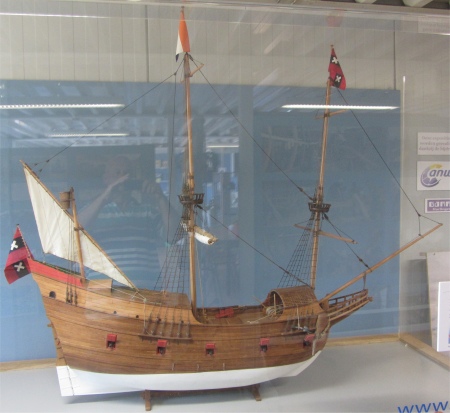 Model of the Ship Barentsz Would Have Sailed In |
In the late 16th century, the Dutch had an interest in the Orient, though at the time it seemed dangerous to contest the Portuguese monopoly of the route around the Cape of Good Hope. In 1595 Amsterdam merchants, undiscouraged by the English failure to find a Northeast Passage 40 years earlier, decided to resume the search. The Town Council of Amsterdam purchased and outfitted two small ships, captained by Jan Rijp and Jacob van Heemskerk, to search for the elusive channel under the command of Barentsz.
The ships departed on May 18th, 1596, and about three weeks later discovered Bear Island, south of the then-unknown Spitsbergen; they so named the island because of an encounter with a polar bear whose hide did not prove vulnerable to Dutch blunderbusses. Pressing northward, the Dutch ships came across the previously undiscovered uninhabited Spitsbergen islands on June 17th. During the rest of June the Dutch explored the western coast of the main island, thinking it a part of Greenland.
The ships returned to Bear Island on 1st July. Here, anxieties over possible entrapment by ice resulted in a disagreement between Barentsz and Van Heemskerk on one side and Rijp on the other. They agreed to part ways, with Barentsz continuing northeast, while Rijp headed due north to resume exploration of Spitsbergen. Barentsz reached Novaya Zemlya on 17th July, previously discovered but not explored to its northern limit. Barentsz and Heemskerck rounded the northernmost point, naming it Hook of Desire, and sailed eastward, at first believing, from the open water encountered, that they had discovered the Northeast Passage. By November, however, the ice had grown thick and it finally imprisoned the ship. Barentsz and Heemskerck were 81�N at their highest latitude, beyond any point previously reached. Still close to Novaya Zemlya, they realised that they must build a solid shelter ashore in order to survive. They made one of logs and driftwood and moved into this 7.8x5.5m "Safe House" in October.
Dealing with extreme cold, the crew realised that their socks would burn before their feet could even feel the warmth of a fire, and took to sleeping with warmed stones and cannonballs. In addition, they used the merchant fabrics aboard the ship to make additional blankets and clothing. The ship bore salted beef, butter, cheese, bread, barley, peas, beans, groats, flour, oil, vinegar, mustard, salt, beer, wine, brandy, hardtack, smoked bacon, ham and fish. Much of the beer froze, bursting the casks. Proving successful at hunting, the group caught 26 Arctic foxes in primitive traps, as well as killing a number of polar bears. By 8th November, Gerrit de Veer, the ships carpenter who kept a diary, reported a shortage of beer and bread, with wine being rationed four days later. In January 1597, De Veer became the first person to witness and record the atmospheric anomaly known as the Novaya Zemlya effect.
Conditions then deteriorated; the firewood gave out, and the ship was crushed by ice. The men began to construct two small boats. Scurvy had been present for months, and one of the worst sufferers was Barentsz. He left on 13th June with the rest as they slowly worked down Novaya Zemlya, but he grew so weak that he could take no part in manipulating the craft. Barentsz died at sea on 20th June 1597, soon after asking Gerrit de Veer, chronicler of the expedition, to lift him up for a final look at Novaya Zemlya. Heemskerck and the other survivors reached the Kola Peninsula after seven more weeks, where they were rescued by a Russian merchant vessel, and by that time only 12 crewmen remained. They heard of a Dutch ship not far off, and a messenger was sent to ascertain whether it would rescue them. By pure coincidence the Dutch vessel was captained by Rijp, who had returned to Holland and come back for trade. Ultimately, they did not reach Amsterdam until 1st November.
In the 1870s European ships visited "Safe House" and found it partially caved in by snow. Objects left there by the Dutch explorers are in the Rijksmuseum in Amsterdam.
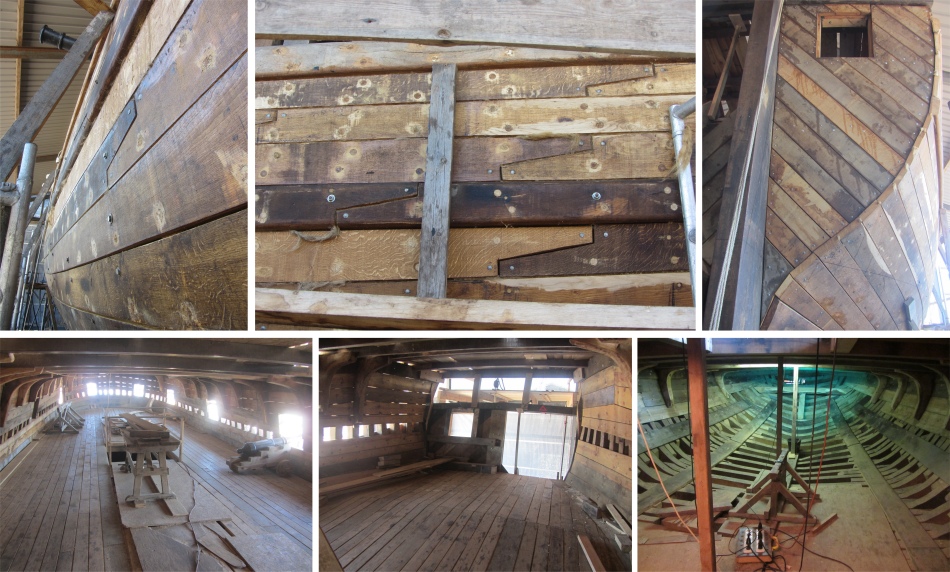 Ship Replica under Construction |
As we saw it, the main shape of the replica was established. The oak ribs were being given an outer skin of 5cm thick pine planks. The old man explained, "The planks are not shaped in a steam tunnel. Instead they are soaked for three days, and then blow torches are applied to introduce the flexibility into the timbers. The planks are held in place with long, oak spikes, about 2cm diameter. These are hammered home, and splayed out at each end with wooden wedges. At key positions, metal bolts are used. The original ship would have had long metal spikes, a portion of which would stick out from the vessel, and would inflict serious damage to unwelcome ships coming alongside."
The caulking still had to be completed between the planks. Inside the upper floor was low ceilinged - short folk in those days. Our guide pointed out the oak ribs that supported the upper deck were constructed in three sections, and were sponsored for 100 Euros each. The names of the sponsors were clearly carved into each rib. The man explained that they had originally received a lot of financial backing for the enterprise, but the recession brought a halt to that.
 "There's a Hole in the Dyke" |
We thanked the old man for his time and enthusiasm, and made a healthy contribution to the donation box.
 Stadhuis |
We returned to Duonita so that Rex could rest his back. In the afternoon I took myself on a hike to stretch my legs. I headed north from our mooring place, passing through a pretty residential area which surprisingly contained a dozen properties with thatched roofs.
The road brought me up to the Van Harinxmakanaal, which I skirted passing a trawler, two dredgers and a motley collection of other barges. Taking a long detour through a huge industrial estate, I spotted a bridge over the canal 500m further up. In my wisdom I thought I'd make my way up to the bridge, cross the canal, and return back down to Harlingen. I had to take a very convoluted route through the industrial estate to find the road that crossed the canal. I cursed fluently when I discovered that the bridge was for vehicles only.
Not to be disappointed, I headed due south, passing a major road construction on the way, and after a while entered a vast, modern residential area, very green, but rather boring to walk through. I eventually turned west and headed back towards Harlingen centre.
 Harlingen Thatched Roofs |
For three centuries Harlingen Catholics had struggled in a shelter close to a narrow alley near the church. Then, in 1879, with the approval of the then Archbishop of Utrecht, it was decided to build a new church and parsonage. The construction of this church was completed in 1881, and it was dedicated ceremonially on May 31st. The architect was Alfred Tepe from Utrecht, who also built the Roman Catholic church of Workum. Contractor company Joh.K.Kalt from Ureterp built the church in the place of the old shelter church between the Zuiderhaven and the Schritsen, in the direction north-south (other than the traditional east-west line).
During the Second World War, the tower was hit by an English fire bomb. Later on November 5th, 1941, church and sacristy on the north side were badly damaged by a bomb attack. After the war the choice was demolition or restoration? The choice was simple, and monumental character and characteristic construction were chosen for restoration. In the period 1985-1999 a great restoration took place. The church is now a national monument. The pulpit, the high altar and the side altars come from the studio of sculptor Friedrich Wilhelm Mengelberg. The acrylic glass windows are made by Jan Murk de Vries, and the organ of 1898 was built by Adema.
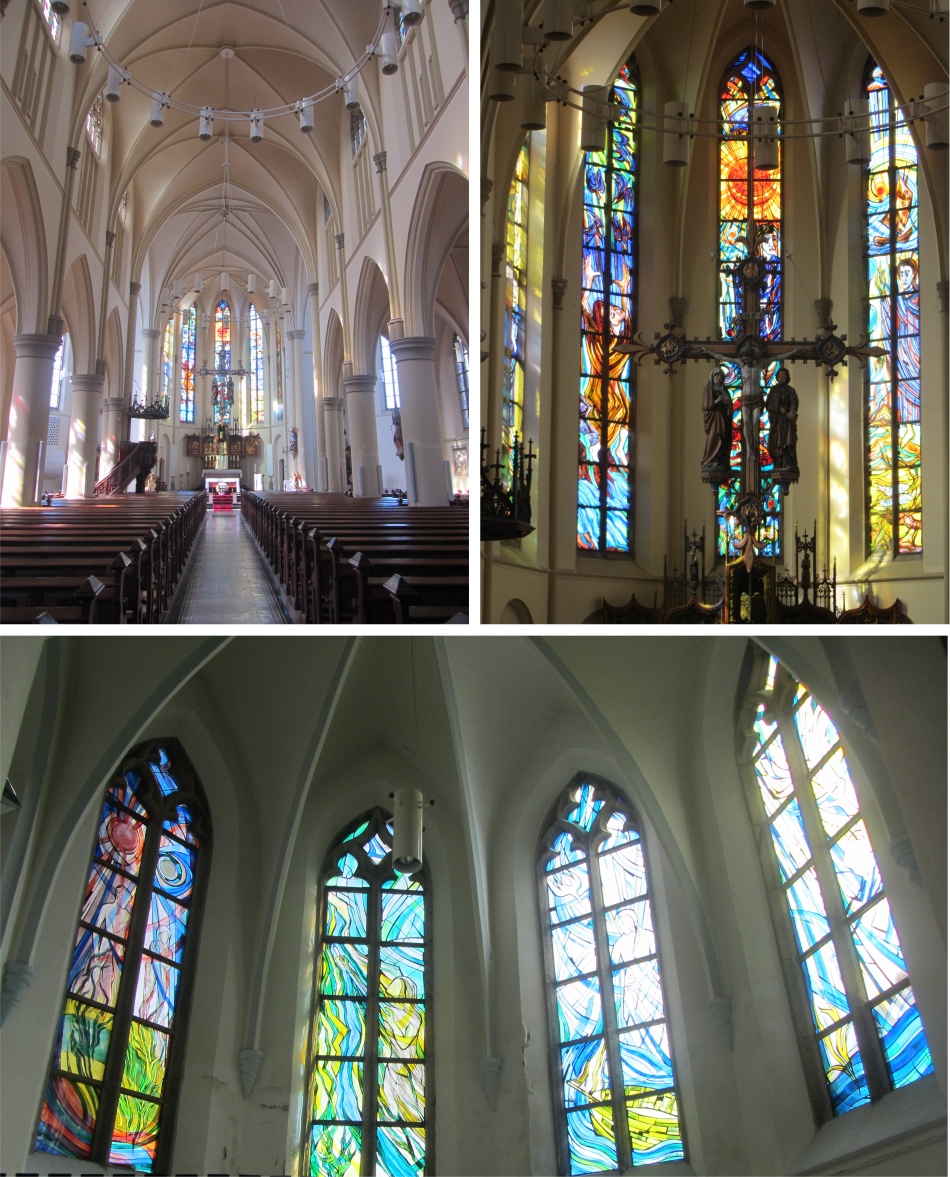 Sint Michaelkerk |
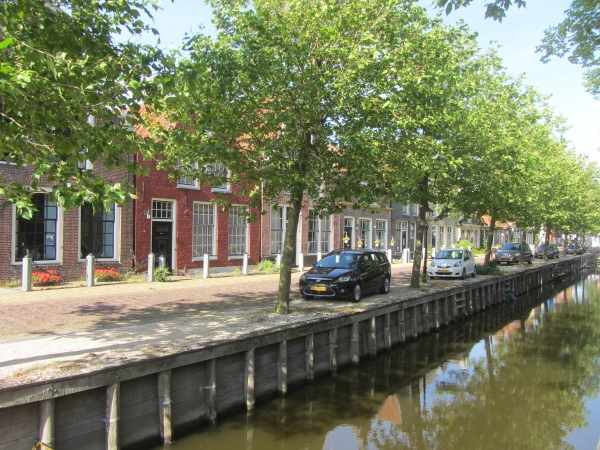 Zoutsloot |
I found Rex busying himself playing games on his iPad. It did not take a great deal of persuasion to drag him off for a couple of beers and some food.
